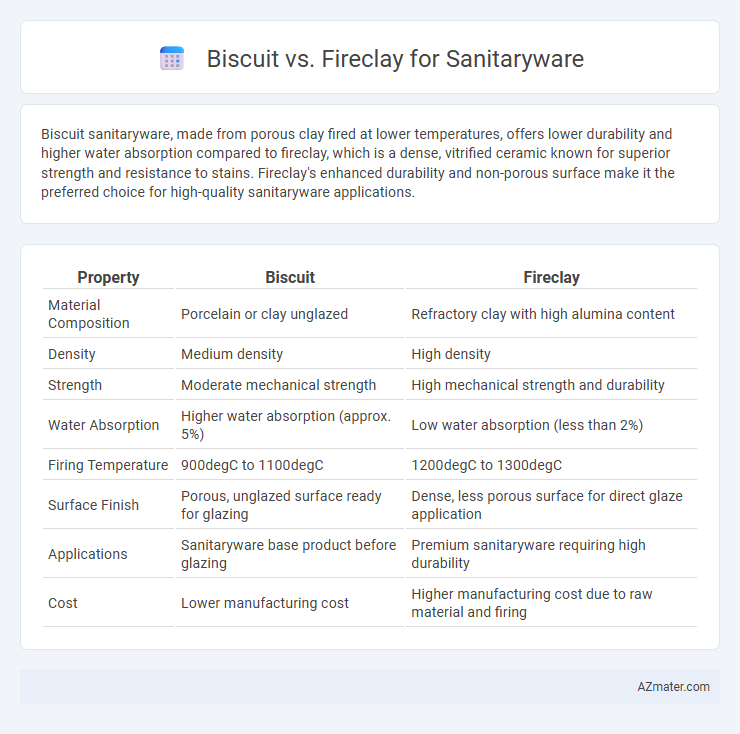Biscuit sanitaryware, made from porous clay fired at lower temperatures, offers lower durability and higher water absorption compared to fireclay, which is a dense, vitrified ceramic known for superior strength and resistance to stains. Fireclay's enhanced durability and non-porous surface make it the preferred choice for high-quality sanitaryware applications.
Table of Comparison
| Property | Biscuit | Fireclay |
|---|---|---|
| Material Composition | Porcelain or clay unglazed | Refractory clay with high alumina content |
| Density | Medium density | High density |
| Strength | Moderate mechanical strength | High mechanical strength and durability |
| Water Absorption | Higher water absorption (approx. 5%) | Low water absorption (less than 2%) |
| Firing Temperature | 900degC to 1100degC | 1200degC to 1300degC |
| Surface Finish | Porous, unglazed surface ready for glazing | Dense, less porous surface for direct glaze application |
| Applications | Sanitaryware base product before glazing | Premium sanitaryware requiring high durability |
| Cost | Lower manufacturing cost | Higher manufacturing cost due to raw material and firing |
Introduction to Sanitaryware Materials
Sanitaryware materials primarily include biscuit and fireclay, each offering distinct properties for bathroom fixtures. Biscuit refers to unglazed ceramic that is smooth, dense, and easier to clean, making it popular for modern sanitaryware. Fireclay, a strong, vitrified clay fired at high temperatures, provides exceptional durability and resistance to chipping and stains, favored in commercial and high-traffic settings.
What is Biscuit in Sanitaryware?
Biscuit in sanitaryware refers to the unfired or partially fired ceramic material shaped into sanitary products such as toilets, basins, and sinks before glazing and final firing. This stage has a porous surface that allows the glaze to bond effectively, enhancing durability and water resistance. Biscuit quality impacts the strength, finish, and overall appearance of the final sanitaryware product.
Understanding Fireclay as a Material
Fireclay, a dense and durable ceramic material composed primarily of kaolin and feldspar, offers superior strength and resistance to thermal shock compared to conventional biscuit sanitaryware. Its vitrified surface provides enhanced stain resistance and a smoother finish, making it ideal for long-lasting toilets, sinks, and basins. Understanding fireclay's composition helps in selecting sanitaryware that combines aesthetic appeal with exceptional durability and low porosity.
Manufacturing Process: Biscuit vs Fireclay
Biscuit sanitaryware is manufactured through a single firing process where shaped ceramic pieces are fired at high temperatures to create a hard, porous body that is later glazed and refired. In contrast, fireclay is produced by mixing specific clays and undergoing a similar high-temperature firing process but tends to offer greater durability and resistance to thermal shock due to its denser composition. The manufacturing of fireclay involves refining raw materials to enhance hardness and longevity, making it preferable for heavy-duty sanitary applications compared to standard biscuit ware.
Durability Comparison: Biscuit vs Fireclay
Fireclay sanitaryware demonstrates superior durability compared to biscuit ware due to its higher firing temperature and dense ceramic composition, making it more resistant to chipping, cracks, and thermal shock. Biscuit sanitaryware, while adequate for general use, tends to be more porous and susceptible to surface damage over time, reducing its lifespan in high-use environments. Fireclay's enhanced strength and resistance to wear make it a preferred choice for long-lasting fixtures in commercial and residential bathrooms.
Aesthetic Differences and Finishes
Biscuit sanitaryware exhibits a smooth, matte surface with natural off-white or cream tones, providing a subtle, understated aesthetic ideal for classic bathroom designs. Fireclay sanitaryware features a dense, high-gloss finish with a brighter white appearance, offering a sleek, modern look with enhanced durability and stain resistance. Fireclay's glazing produces a more reflective and smooth texture, contributing to a cleaner, more polished visual impact compared to biscuit's softer, organic finish.
Cost Analysis: Biscuit vs Fireclay
Biscuit sanitaryware is generally more cost-effective than fireclay due to lower raw material and manufacturing expenses, making it a preferred choice for budget-conscious projects. Fireclay, although more expensive, offers superior durability and resistance to chipping and scratching, which can reduce long-term maintenance costs. The initial cost difference between biscuit and fireclay may be offset by the latter's longevity and lower replacement frequency in high-use environments.
Maintenance and Care Requirements
Biscuit sanitaryware requires less frequent deep cleaning due to its glazed, durable surface that resists staining and water absorption, making maintenance straightforward with regular wiping and mild detergents. Fireclay, while highly resistant to scratches and chemical damage, demands more careful cleaning routines using non-abrasive cleaners to preserve its matte finish and prevent dulling over time. Both materials benefit from prompt removal of hard water deposits and avoidance of harsh chemicals to maintain their aesthetic appeal and longevity in bathrooms.
Environmental Impact and Sustainability
Biscuit sanitaryware, typically made from basic clay fired at lower temperatures, consumes less energy during production but often lacks durability, leading to more frequent replacements and increased waste. Fireclay sanitaryware, fired at higher temperatures with specially refined clay, offers greater durability and longevity, reducing the need for replacements and minimizing landfill waste over time. The sustainable choice depends on balancing initial energy consumption with product lifespan, where fireclay provides a more eco-friendly option through enhanced durability and reduced resource use.
Choosing the Right Material for Your Needs
Biscuit sanitaryware offers a traditional, porous finish that allows for further customization with glazing, making it ideal for projects requiring a matte or unique surface. Fireclay sanitaryware features a much denser, durable composition with a non-porous, smooth finish that resists scratches and stains, providing enhanced longevity and easier maintenance. Selecting between biscuit and fireclay depends on the desired durability, maintenance level, and aesthetic customization for your bathroom fixtures.

Infographic: Biscuit vs Fireclay for Sanitaryware
 azmater.com
azmater.com